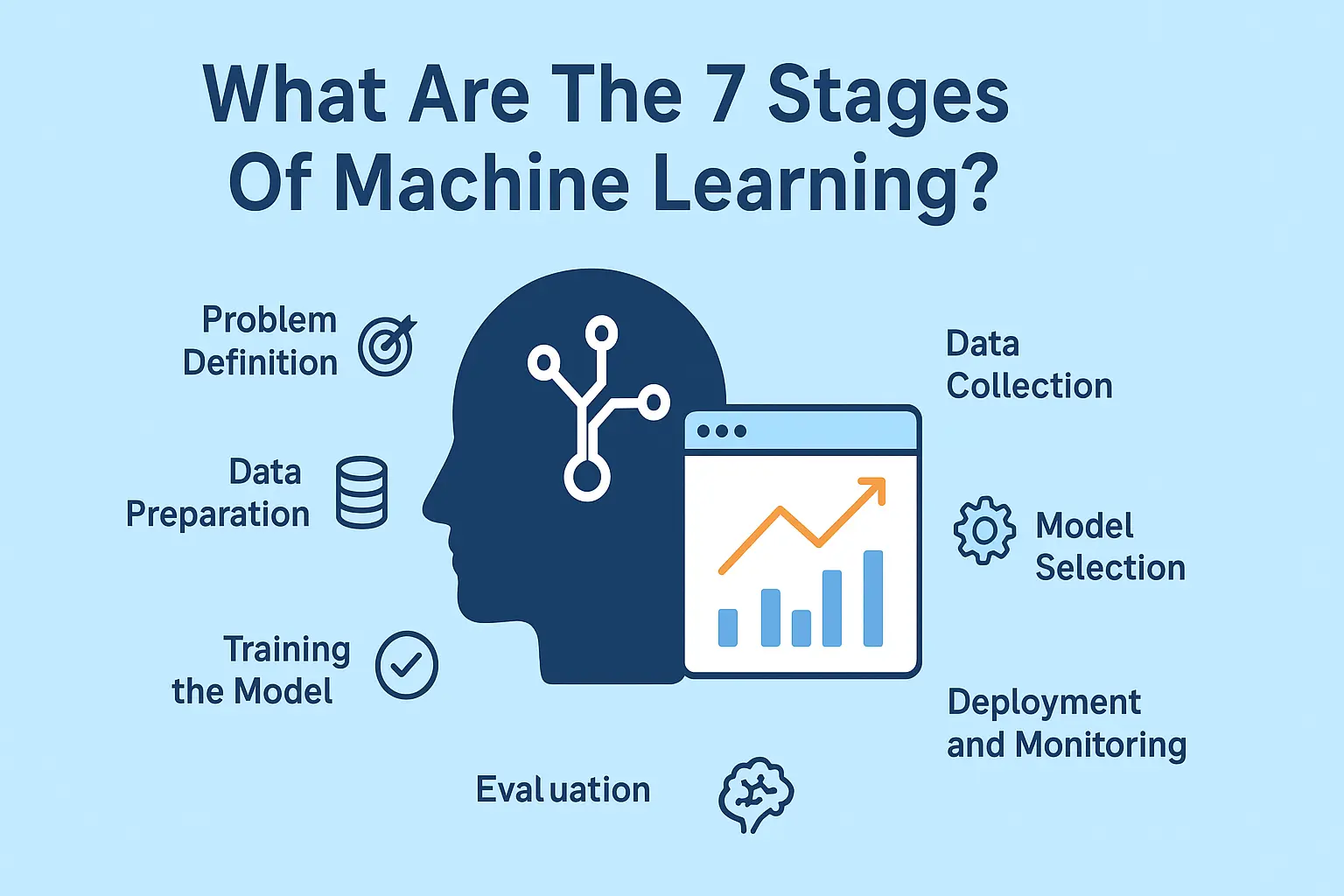Most of the tools we use daily are driven by machine learning. It operates silently in the background through voice assistants and spam filters. However, machine learning has a certain direction behind the scenes. This process is divided into seven stages by experts. Each phase is a continuation of the previous one. The 7 stages of machine learning in simple terms, let us go through them.

Table of Contents
1.Problem Definition
The initial process is to be aware of the problem you want to solve. Nothing is important without a definite issue. As an illustration, a firm might be interested in forecasting customer churn. A hospital might wish to identify the early signs of a disease. These are specific problems. At this level, goals, limits, and measures of success are determined by the team.
Questions asked here:
- What is it we are predicting or classifying?
- Who will use the result?
- How will success be measured?
After defining the problem, the remainder of the process is guided. Imagine that this step is the sketching of the map before the journey begins.
2.Data Collection
Machine learning requires data, and a car requires fuel. The second phase involves gathering such data. The sources can be company documents, open data, sensors, social media, or customer reviews.
Better data is more than plenty data. In case the information is inaccurate, the model will not work. This is referred to as garbage in, garbage out. At this point, the group also ensures that the data adheres to privacy regulations. In the case of medical data, patient identity should be safeguarded.
The objective is straightforward: collect enough credible information to learn on the model.

3.Data Preparation
Raw data is seldom in place to be used. It is usually filled with mistakes, omissions, or redundancies. The third phase is cleaning and preparing it.
Tasks here include:
- Removing empty values
- Correcting errors
- Handling missing data
- Normalizing numbers
Numbers The conversion of text into numbers.
The process is also referred to as data wrangling. It might be a dull thing to hear, but it is essential. The model is strengthened with clean data. Indeed, according to most professionals, they spend most of their time in this phase.
4.Model Selection
Now comes the creative part. What kind of machine learning model are we supposed to use? The solution will be problem dependent.
A regression model can be appropriate in predicting numbers. To classify emails as spam or non-spam, a decision tree or a logistic regression can be used. Neural networks are used to recognize images.
The team can experiment with various models and compare the outcomes. Model selection is the choice of the right tool in a toolbox. Choose the wrong one and the task becomes more difficult.
5.Training the Model
The actual learning occurs during training. The cleansed data is divided into training and test data. The model analyzes the training data. It seeks patterns and constructs rules.
In an example of a spam filter, the model can be trained to know that emails containing the word lottery are spam. In a credit score model, it can be trained that a default raises the risk.

Training can be time and power consuming. Powerful servers or cloud systems can be employed. The longer the training can be the more the data is available.
At this level, the model is a student who is preparing an exam.
6.Evaluation
The model will have to demonstrate its skills after training. Here the testing data is introduced. The model generates forecasts and the outcomes are compared with actual responses.
The most used are accuracy, precision, recall, and F1 score. These, in other words, demonstrate the frequency with which the model is correct and the expense of its falsehoods.
A poor performing model can require additional data, cleaning, or a different model. Assessment is a comparison of the test once the student has completed it.
7.Deployment and Monitoring
The last phase is the implementation of the model. This is called deployment. The model has been incorporated into actual systems. As an example, an email service has spam filter attached. Doctors use a medical image model.
But the job is not over. Models should be monitored frequently. Real-world data evolves with time. What was a successful model last year might not succeed this year. This is called “model drift.” To prevent this, new data is retrained on the model.
The system is useful and trusted with deployment and monitoring.

Why These 7 Stages Matter
The role of machine learning is divided into stages. Missing one can lead to the failure of the entire process. For example:
The model lacks a goal without problem definition.
The model learns the incorrect patterns without data cleaning.
Unmonitored, the model becomes obsolete.
These are 7 machine learning stages that form a complete cycle. When deployment yields results, then teams tend to go back to step one. They sharpen the issue, gather additional information, and refine the model once more.
Real-Life Problem: House-Price Prediction.
We can use these steps on a simple example, house prices prediction.
Problem statement: Estimate the price of a house, depending on such characteristics as size, location, and the number of rooms.
- Data collection: Find property listing and government data on sales.
- Data preparation: delete errors, work with missing room counts, and turn locations into numbers.
- Model choice: Attempt linear regression or decision trees.
- Training: Train the model using past house data.
- Assessment: Predict test houses that were not part of the training.
- Deployment: Integrate the model into a real estate application, and continue to feed it with new sales data.
This demonstrates the real project working stages.
Typical pitfalls in the 7 stages of machine learning.
Although the stages are obvious, difficulties usually emerge:
- Problems with data quality: The absence of data or biased data undermines the model.
- Expensive: The cost of collecting and storing big data sets can be expensive.
- Model bias: When data is biased by some unfair patterns, the model will repeat it.
- Data transformation: Data does not remain the same in real world, and this requires models to change.
- Complexity: There are issues that might require deep learning that is computationally intensive.
The teams should strategize on these challenges to prevent them in the future.
Stages of Future of Machine Learning.
Some of the stages are taking shorter times as tools are being enhanced. Model selection and training can be assisted by automated machine learning (AutoML). The use of cloud platforms simplifies the process of data storage and computation.
Nevertheless, the fundamental machine learning 7 stages have not changed. It will always be centered on problem definition, data collection, cleaning, model choice, training, evaluation, and deployment.
The difference is in the speed and ease with which teams can navigate them.
Final Thoughts
Machine learning does not look complicated, yet it has a straightforward course. Machine learning has 7 stages that direct all projects through the idea to real-world application.
- Define the problem
- Collect data
- Prepare data
- Select a model
- Train the model
- Evaluate results
- Deploy and monitor
These actions transform unintelligent data into intelligent forecasts. Machine learning can be a potent tool of solving actual problems with every step being completed correctly.
Frequently Asked Questions For The 7 Stages Of Machine Learning
Q1.What are the 7 phases of machine learning?
These phases include problem definition, data collection, data preparation, model selection, training, evaluation and deployment.
Q2.Why do we care about data preparation in machine learning?
Clean data makes the model learn the right patterns and improve predictions.
Q3.What is the criteria of a good machine learning model?
You use data that has not been used in training and test accuracy, precision and recall.
Q4.What is the post deployment of a model?
The model is followed and renewed with new data to keep it correct with time.

